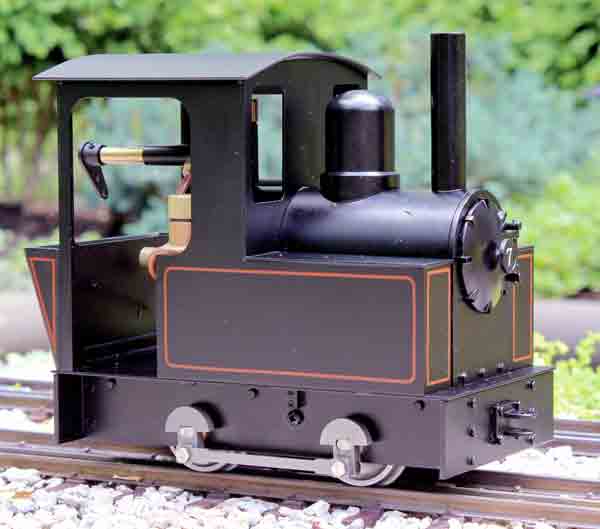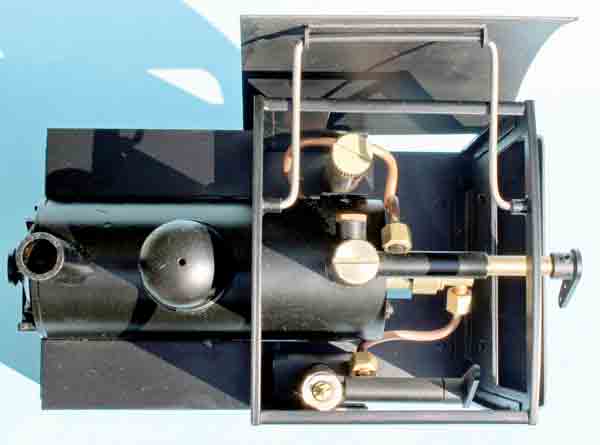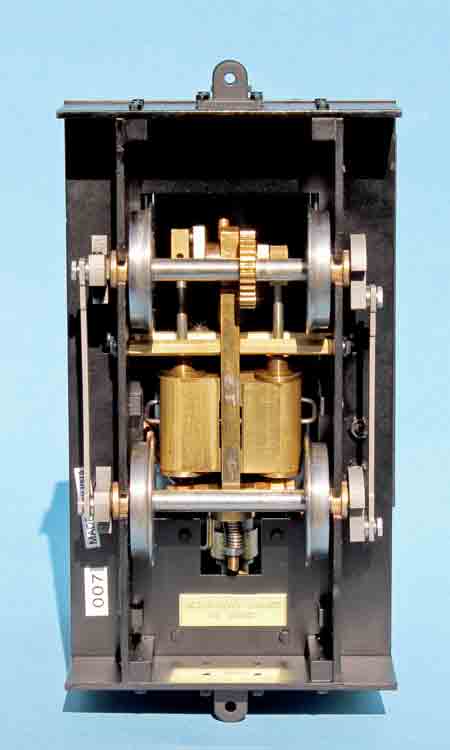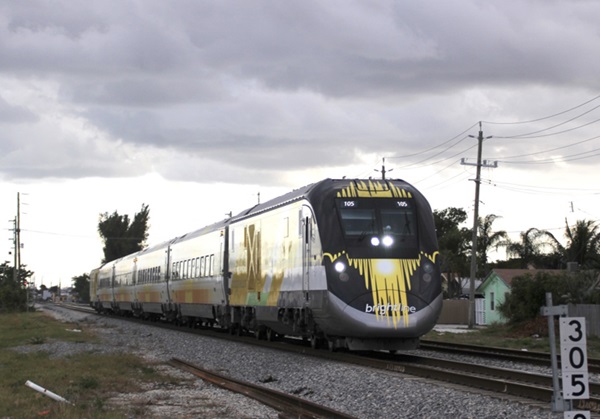Gauge 1, 1:20.3 scale, live steam 0-4-0T
Accucraft Trains
33268 Central Avenue
Union City CA 94587
Price: $435
Website: http://accucraft.com
1:20.3 scale, gauge 1, freelance 0-4-0T live-steam locomotive; gas fired; powered by a two cylinder, oscillating, double-acting steam motor (3⁄8″ bore x ½” stroke); geared 2:1 to the axle; rotary-valve reversing with lever in cab; throttle; safety valve; displacement lubricator; working pressure, 30psi ; tools, syringes, cotton gloves, and instruction booklet included. Dimensions: length over end beams, 6½”; width, 3½”; height over stack, 6″. Weight 4 pounds
Pros: Robust construction, simple design, quiet burner, excellent slow-speed operation, handsome lining
Cons: Reverse lever not easily accessible
Those seeking large, live-steam locomotives are well served in today’s marketplace. Those who have a small garden railway (or a small budget) are not so fortunate. Accucraft’s new Dora bucks the large-engine trend. This is a tiny locomotive! I can easily hold it in one hand. Dora is a freelance 0-4-0T, side tank, narrow-gauge locomotive built nominally to 1:20.3 scale. It is reminiscent of those tireless little workhorses seen around quarries, docks, and industrial complexes in the late 19th century. Although it does look North American in origin, it could easily represent a locomotive of British or continental European manufacture with a few additional detail bits. Dora was designed by Marc Horovitz, and shares many similarities to his scratchbuilt locomotive Indefatigable, shown in the “Staff corner” of the June 2012 of GR and online at www.sidestreetbannerworks.com/Gallery/Gallery24/Ga24.html
The engine arrived in Accucraft’s usual heavy-duty packaging, securely taped to a piece of plywood and double boxed. Included was an instruction booklet, gloves, two syringes (a large one for water, a smaller one to drain the lubricator, Allen keys, spare bolts and nuts, and what appears to an extension pipe for the gas-filler valve (no mention is made of this in the instruction booklet.)
The body is robustly made from thick steel and should be able stand up to rough-and-tumble use. Dora is painted in satin black, with a red lining job providing a nice touch. There is a small coal bunker at the back that could be filled with a dummy coal load. Couplers are minimal, being just two flat pieces of metal with a hole in them. (I used coupling pins made from shortened, unused pop rivets when I hooked it up to a train.) There are small levers in the cab for the gas and throttle valves, which I find much easier for fine control than the knobs used previously on other Accucraft entry-level locomotives.
The engine is powered by a steam motor comprised of two double-acting oscillating cylinders. The cylinders pivot about a central brass plate and are held in place with a U-shaped piece of spring steel. I estimate the cylinders to have a 38″ bore and a 12″ stroke. The cylinders drive a gear, which engages another gear on the lead axle with a 2:1 reduction. Power is distributed to the rear axle by side rods.
A rotary reversing valve is mounted toward the rear of the steam motor and a lever protrudes from the floor of the cab, behind the boiler. It is accessible through the cab door on each side. Although the manual says that radio control can be fitted to Dora, it will be a significant challenge, given the position of the reversing lever and the overall space available on this tiny engine.
The boiler has a single flue and an opening smokebox door. The roof is hinged to allow access to the boiler filling plug and the gas tank. An extra tap on the steam turret in the cab will allow for the addition of a pressure gauge. I calculated the boiler capacity to be a mere five cubic inches and the gas tank is only 158″ x 1 1⁄8″ x 1⁄2″. The safety valve is hidden under a hefty steam dome. The instruction booklet states that the gas tank is sized so the gas will be used up before the boiler is empty.
I prepared Dora following the usual drill. I filled the boiler with distilled water (via the filler plug in the cab) and drew off 20ml to create space for steam to form. I oiled the gears, axle bearings, and connecting rods with lightweight machine oil, and filled the displacement lubricator in the cab with steam oil. Finally, I filled the gas tank with butane.
It was sunny and warm (78°F) on the day of the test run. I opened the smokebox door and held a lighter to the front while I opened the gas valve. The fire flashed back into the flue and I cut the gas back slightly. This little engine has a very quiet burner, barely audible above the noises of the garden.
After three minutes, steam began to bubble out the vent hole in the top of the steam dome. I set the reverser to forward and opened the steam valve. After a few spits of condensate up the stack, Dora trundled off at a sedate speed. Even with the throttle wide open, the locomotive moved at a relatively slow pace, thanks to the reduction gearing. After about 10 minutes, the gas ran out and the run was over (as expected, since this is a very tiny boiler). Upon checking, there was about a tablespoon of water left in the boiler. For the second run, I hung six four-wheel open wagons on behind. Dora pulled these with ease and probably could have handled more.
My only major gripe about the locomotive was the reversing lever. It is not very accessible and tends to get warm during operation. I made up an extension lever from scrap brass, bent to clear the burner assembly and protrude into the rear cab opening (below the throttle). The existing lever (heavy brass wire) appears to be threaded into the reverser, and might simply be replaced by a longer lever of the same size brass wire.
This delightful little locomotive will have wide appeal. It is an easy-to-run engine and attractively priced, for those who are looking for their first live-steam locomotive. Its size lends itself to those with smaller garden railways with tight curves. Its slow-speed operation would be ideal for a live-steam switching layout. Finally, kitbashers will appreciate its simple design and construction. In fact, the instruction booklet states the body is easily removed to accommodate modifications. I could see it easily converted into the single locomotive-and-coach steam motor “Coffee Pot” that currently resides on the Pichi Richi Railway in Australia. With a new body, it would make a delightful tram engine. With a larger boiler, two of the locomotive chassis could be combined into a wonderful little Garratt locomotive. The possibilities are limitless.
If you are looking for your first live steam engine, a simple locomotive for a small railway, or an affordable basis for a kitbashing project, Dora can’t be beat.
















